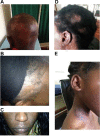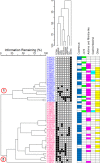Evidence of a distinct group of Black African patients with systemic lupus erythematosus
- PMID: 30245865
- PMCID: PMC6144901
- DOI: 10.1136/bmjgh-2017-000697
Evidence of a distinct group of Black African patients with systemic lupus erythematosus
Abstract
Background: The autoimmune disease systemic lupus erythematosus (SLE) occurs more frequently in patients of African descent with high morbidity and mortality. Current SLE diagnostic criteria including antinuclear antibody (ANA) reactivity are derived largely from non-African populations. This study characterises ANA reactivity patterns and relates them to SLE clinical presentation in Black African patients.
Methods: Sera from Black participants (61 patients with SLE and 100 controls) aged 1-81 years were analysed for reactivity against the antigens: uridine 1-ribonuclear protein, Smith uridine-1-5 ribonuclear protein antigen, soluble substance-A, recombinant Ro-52, soluble substance-B, Scl-70, cytoplasmic histidyl-tRNA synthetase antigen, proliferating cell nuclear antigen (PCNA), nucleosomes, ribonuclear P-protein, antimitochondrial antibody M2 (AMA-M2), histones, double-stranded DNA (dsDNA), centromere protein B and polymyositis-sclerosis overlap antigen.
Findings: A significantly higher proportion (97%) of the 61 patients with SLE had detectable autoantibody reactivity compared with 15% of the 100 controls (p<0.001). The highest frequencies of autoantibody reactivity in patients with SLE were against the dsDNA antigen (41%) and PCNA (54%). Anti-PCNA and anti-dsDNA reactivity were mutually exclusive (p<0.001) giving rise to two distinct groups of Black African patients with SLE. The first group (n=25) had reactivity profiles consistent with international standard SLE definitions, including anti-dsDNA reactivity, and was 13 times more likely to present with joint symptoms. The larger, second group (n=34), characterised by anti-PCNA and anti-AMA-M2 reactivity, was nine times more likely to present with only cutaneous symptoms.
Interpretation: Our study demonstrates a need to extend autoantibody panels to include anti-PCNA in the diagnostic process of Black African patients and further refine the predictive values of the reactivity to different antigens to differentiate SLE syndromes in African populations.
Keywords: elisa; public health; screening; serology.
Conflict of interest statement
Competing interests: None declared.
Figures





Comment in
-
Africa should set its own health-research agenda.Nature. 2019 Nov;575(7784):567. doi: 10.1038/d41586-019-03627-9. Nature. 2019. PMID: 31772371 No abstract available.
Similar articles
-
Identification of specific antinuclear antibodies in dogs using a line immunoassay and enzyme-linked immunosorbent assay.Vet Immunol Immunopathol. 2015 Dec 15;168(3-4):233-41. doi: 10.1016/j.vetimm.2015.10.002. Epub 2015 Oct 9. Vet Immunol Immunopathol. 2015. PMID: 26547884
-
Autoantibodies predate the onset of systemic lupus erythematosus in northern Sweden.Arthritis Res Ther. 2011 Feb 22;13(1):R30. doi: 10.1186/ar3258. Arthritis Res Ther. 2011. PMID: 21342502 Free PMC article.
-
Clinical value of chemiluminescence method for detection of antinuclear antibody profiles.World J Clin Cases. 2023 Oct 6;11(28):6688-6697. doi: 10.12998/wjcc.v11.i28.6688. World J Clin Cases. 2023. PMID: 37901001 Free PMC article.
-
[Modern look at the problems of investigation of antinuclear antibodies in systemic lupus erythematosus (literature review).].Klin Lab Diagn. 2018;63(6):340-348. doi: 10.18821/0869-2084-2018-63-6-340-348. Klin Lab Diagn. 2018. PMID: 30702224 Review. Russian.
-
The use of laboratory tests in the diagnosis of SLE.J Clin Pathol. 2000 Jun;53(6):424-32. doi: 10.1136/jcp.53.6.424. J Clin Pathol. 2000. PMID: 10911799 Free PMC article. Review.
Cited by
-
Coagulation Status and Venous Thromboembolism Risk in African Americans: A Potential Risk Factor in COVID-19.Clin Appl Thromb Hemost. 2020 Jan-Dec;26:1076029620943671. doi: 10.1177/1076029620943671. Clin Appl Thromb Hemost. 2020. PMID: 32702995 Free PMC article.
-
Impact of patient ancestry on heterogeneity of Sjögren's disease.RMD Open. 2023 Mar;9(1):e002955. doi: 10.1136/rmdopen-2022-002955. RMD Open. 2023. PMID: 36878621 Free PMC article.
References
Grants and funding
LinkOut - more resources
Full Text Sources
Other Literature Sources
Research Materials
Miscellaneous
